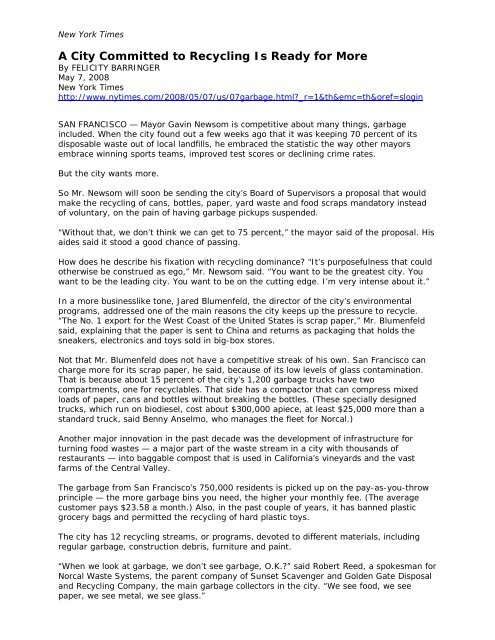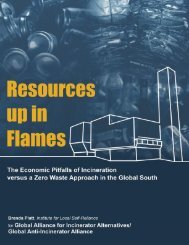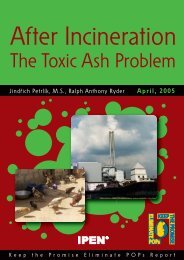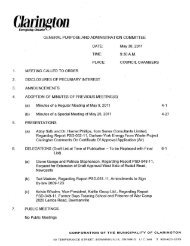A City Committed to Recycling Is Ready for More
A City Committed to Recycling Is Ready for More - Durham ...
A City Committed to Recycling Is Ready for More - Durham ...
- No tags were found...
You also want an ePaper? Increase the reach of your titles
YUMPU automatically turns print PDFs into web optimized ePapers that Google loves.
New York Times<br />
A <strong>City</strong> <strong>Committed</strong> <strong>to</strong> <strong>Recycling</strong> <strong>Is</strong> <strong>Ready</strong> <strong>for</strong> <strong>More</strong><br />
By FELICITY BARRINGER<br />
May 7, 2008<br />
New York Times<br />
http://www.nytimes.com/2008/05/07/us/07garbage.html?_r=1&th&emc=th&oref=slogin<br />
SAN FRANCISCO — Mayor Gavin Newsom is competitive about many things, garbage<br />
included. When the city found out a few weeks ago that it was keeping 70 percent of its<br />
disposable waste out of local landfills, he embraced the statistic the way other mayors<br />
embrace winning sports teams, improved test scores or declining crime rates.<br />
But the city wants more.<br />
So Mr. Newsom will soon be sending the city’s Board of Supervisors a proposal that would<br />
make the recycling of cans, bottles, paper, yard waste and food scraps manda<strong>to</strong>ry instead<br />
of voluntary, on the pain of having garbage pickups suspended.<br />
“Without that, we don’t think we can get <strong>to</strong> 75 percent,” the mayor said of the proposal. His<br />
aides said it s<strong>to</strong>od a good chance of passing.<br />
How does he describe his fixation with recycling dominance? “It’s purposefulness that could<br />
otherwise be construed as ego,” Mr. Newsom said. “You want <strong>to</strong> be the greatest city. You<br />
want <strong>to</strong> be the leading city. You want <strong>to</strong> be on the cutting edge. I’m very intense about it.”<br />
In a more businesslike <strong>to</strong>ne, Jared Blumenfeld, the direc<strong>to</strong>r of the city’s environmental<br />
programs, addressed one of the main reasons the city keeps up the pressure <strong>to</strong> recycle.<br />
“The No. 1 export <strong>for</strong> the West Coast of the United States is scrap paper,” Mr. Blumenfeld<br />
said, explaining that the paper is sent <strong>to</strong> China and returns as packaging that holds the<br />
sneakers, electronics and <strong>to</strong>ys sold in big-box s<strong>to</strong>res.<br />
Not that Mr. Blumenfeld does not have a competitive streak of his own. San Francisco can<br />
charge more <strong>for</strong> its scrap paper, he said, because of its low levels of glass contamination.<br />
That is because about 15 percent of the city’s 1,200 garbage trucks have two<br />
compartments, one <strong>for</strong> recyclables. That side has a compac<strong>to</strong>r that can compress mixed<br />
loads of paper, cans and bottles without breaking the bottles. (These specially designed<br />
trucks, which run on biodiesel, cost about $300,000 apiece, at least $25,000 more than a<br />
standard truck, said Benny Anselmo, who manages the fleet <strong>for</strong> Norcal.)<br />
Another major innovation in the past decade was the development of infrastructure <strong>for</strong><br />
turning food wastes — a major part of the waste stream in a city with thousands of<br />
restaurants — in<strong>to</strong> baggable compost that is used in Cali<strong>for</strong>nia’s vineyards and the vast<br />
farms of the Central Valley.<br />
The garbage from San Francisco’s 750,000 residents is picked up on the pay-as-you-throw<br />
principle — the more garbage bins you need, the higher your monthly fee. (The average<br />
cus<strong>to</strong>mer pays $23.58 a month.) Also, in the past couple of years, it has banned plastic<br />
grocery bags and permitted the recycling of hard plastic <strong>to</strong>ys.<br />
The city has 12 recycling streams, or programs, devoted <strong>to</strong> different materials, including<br />
regular garbage, construction debris, furniture and paint.<br />
“When we look at garbage, we don’t see garbage, O.K.?” said Robert Reed, a spokesman <strong>for</strong><br />
Norcal Waste Systems, the parent company of Sunset Scavenger and Golden Gate Disposal<br />
and <strong>Recycling</strong> Company, the main garbage collec<strong>to</strong>rs in the city. “We see food, we see<br />
paper, we see metal, we see glass.”
The recycling rate <strong>for</strong> this curbside collection from homes, hotels and the city’s 5,000<br />
restaurants is considerably lower than the overall rate, Mr. Reed said, in part because the<br />
rates on other waste streams — construction debris or material, like batteries and compact<br />
fluorescent bulbs, that the public brings in <strong>to</strong> special centers — is much higher.<br />
Much of the concrete from demolished buildings, <strong>for</strong> instance, is recycled in new sidewalks.<br />
Another recycling stream is born of the community’s design sensitivities. “People are doing<br />
very well here,” Mr. Reed said. “They remodel, and they paint. On Thursdays, Fridays and<br />
Saturdays, people line up <strong>to</strong> bring us paint” at a facility built <strong>for</strong> the purpose.<br />
“We separate it in<strong>to</strong> flat and latex, screen it <strong>to</strong> take out the chunks, and blend it in 55-<br />
gallon drums,” he said.<br />
The three resulting colors — off-white, beige and green — are packed in five-gallon tins and<br />
sent <strong>to</strong> local nonprofit organizations, schools or charitable institutions in Mexico.<br />
Norcal’s subsidiaries handle 3,545 <strong>to</strong>ns of waste a day in San Francisco, out of about 7,800<br />
generated citywide, Mr. Reed said. About 55 percent of Norcal’s <strong>to</strong>tal goes <strong>to</strong> the landfill;<br />
the rest is recycled. These figures become part of the calculation of the city’s overall<br />
diversion rate of 70 percent, which is the figure it just reported <strong>for</strong> 2006.<br />
As John Sitts, of the state’s integrated waste management board, said, “the diversion rate<br />
includes recycling, composting and source reduction” — the last term representing<br />
“everything businesses and residents do <strong>to</strong> reuse things rather than throwing them out.”<br />
The Los Angeles region most recently reported a 59 percent diversion rate, a number still<br />
being audited by state regula<strong>to</strong>rs. San Jose, at 62 percent, claims the best-in-class crown<br />
<strong>for</strong> cities of 900,000 or more. Statewide, the figure <strong>for</strong> 2006 was 54 percent.<br />
With the exception of Chicago,<br />
which boasted a 55 percent<br />
rate in 2006 — the most<br />
recent year <strong>for</strong> which national<br />
comparisons are available —<br />
Eastern and Midwestern cities<br />
lagged well behind their<br />
Cali<strong>for</strong>nia counterparts.<br />
According <strong>to</strong> the most recent<br />
annual survey of the trade<br />
magazine Waste News, in<br />
2006 New York <strong>City</strong> was at<br />
30.6 percent, Milwaukee at 24<br />
percent, Bos<strong>to</strong>n at 16 percent<br />
and Hous<strong>to</strong>n at 2.5 percent.<br />
San Francisco’s system is<br />
being noticed overseas. Mr.<br />
Blumenfeld’s calendar is full of<br />
meetings with officials from<br />
Germany and China, most of<br />
whom visit Norcal’s facilities,<br />
including the food-waste<br />
composting centers.<br />
His visi<strong>to</strong>rs are learning, Mr.<br />
Blumenfeld said, that “you can<br />
recycle almost anything.”
Workers sort plastics at the San Francisco <strong>Recycling</strong> Center.<br />
The city, with 7,800 <strong>to</strong>ns of waste a day, keeps 70 percent of<br />
it out of landfills. Mayor Gavin Newsom is shooting <strong>for</strong> 75<br />
percent.<br />
The San Francisco <strong>Recycling</strong> Center processes about 750<br />
<strong>to</strong>ns of recyclables a day, and Mayor Gavin Newsom wants <strong>to</strong><br />
add <strong>to</strong> that <strong>to</strong>tal.






